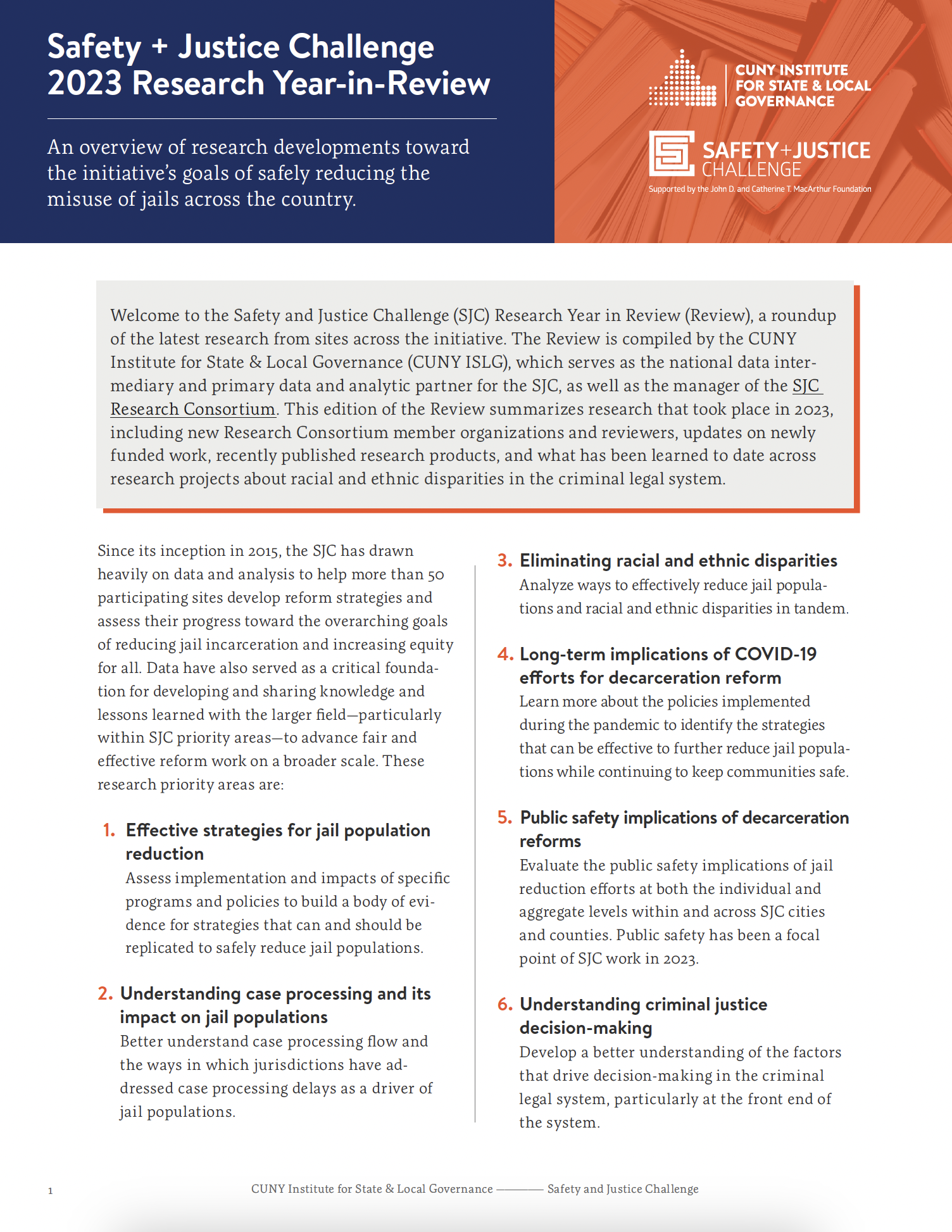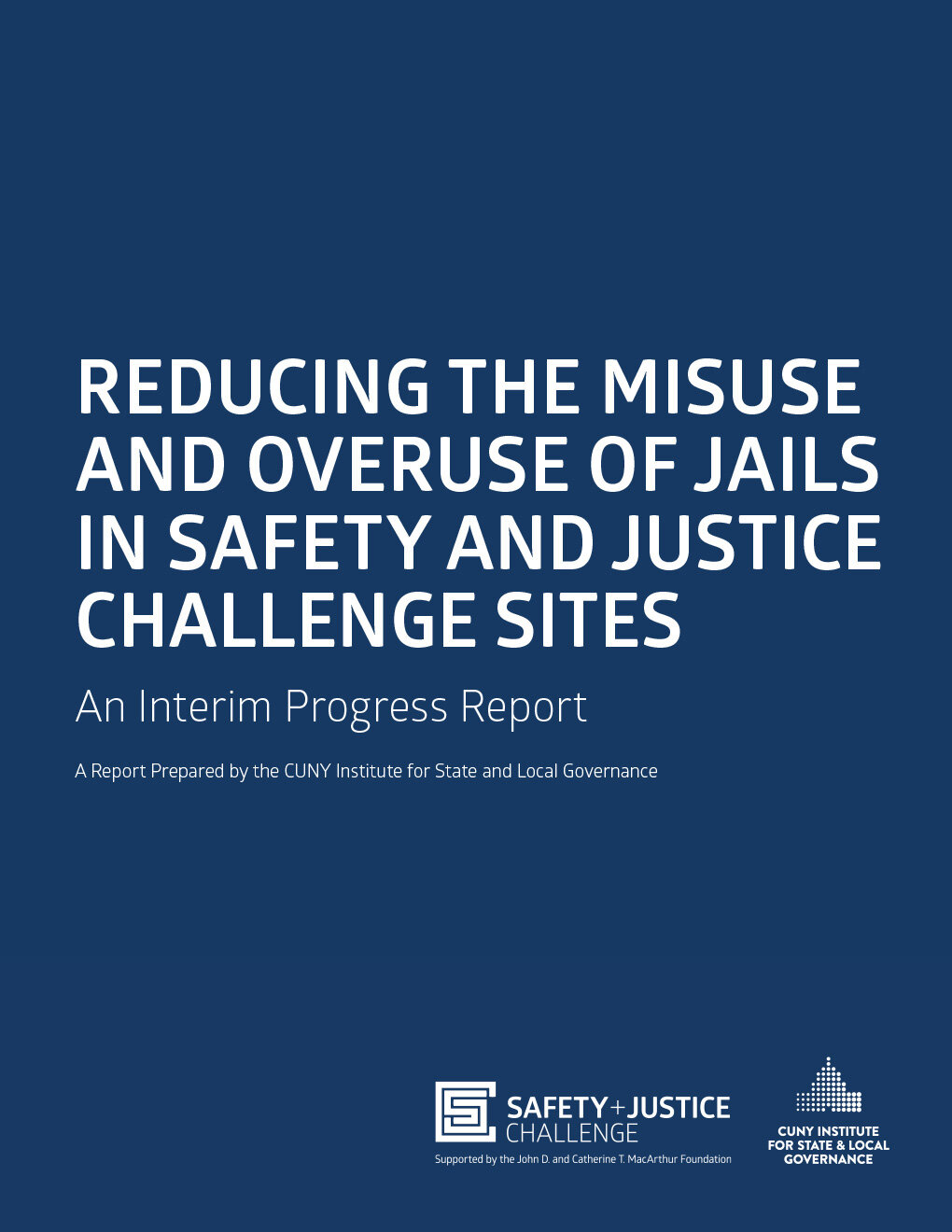RESOURCES
Knowledge Center
Outcomes, discoveries, and analysis from our breadth of good governance initiatives.
![[From Our Partners] Changing the Initial Appearance Process in Three Sites](https://images.squarespace-cdn.com/content/v1/5fcea962a1b4d771ad256fcc/c1efac4e-4db5-4947-b37e-c8a8f1c77706/Changing+the+Initial+Appearance+Process+-+Findings+from+Three+Sites.png)
[From Our Partners] Changing the Initial Appearance Process in Three Sites
CUNY ISLG funded Justice System Partners (JSP) to conduct mixed-methods studies in Cook (IL), Lucas (OH), and Multnomah (OR) counties, where local defense agencies had led programs to systematically enhance due process for individuals at initial appearance.

Safety and Justice Challenge 2024 Research Year-in-Review
This edition of the Review summarizes research activities that took place throughout 2024, including new Research Consortium memberships, updates on newly funded work, and recently published research products, with a spotlight on women and survivors of violence in the criminal legal system.
![[From Our Partners] Evaluation of Emergency COVID-19 Jail Reduction Strategies in Multnomah County, Oregon](https://images.squarespace-cdn.com/content/v1/5fcea962a1b4d771ad256fcc/d6712efc-29a3-4358-8c48-a511473577a4/exec+summary.png)
[From Our Partners] Evaluation of Emergency COVID-19 Jail Reduction Strategies in Multnomah County, Oregon
To learn more about the impact of emergency COVID-19 measures on jail reduction efforts, and think about emergency measures that could continue in the post-pandemic era, CUNY ISLG funded JSP through the SJC to conduct a mixed-methods case study on the emergency jail population reduction strategies implemented in Multnomah County, Oregon.

Lowering Jail Populations Safely Before, During, and After COVID-19
Two years out from COVID-19’s peak, there continues to be no apparent correlation between changes in incarceration and violent crime. Most individuals released from jail on pretrial status did not return to jail custody, and local violent crime rates varied regardless of changes to the jail population—suggesting that jail reduction reforms can be implemented safely.

Safety and Justice Challenge 2023 Research Year-in-Review
This edition of the Review summarizes research that took place in 2023, including new Research Consortium member organizations and reviewers, updates on newly funded work, recently published research products, and what has been learned to date across research projects about racial and ethnic disparities in the criminal legal system.
![[From Our Partners] Achieving Racial Equity and Improving Culture in Jails Using a Community-Engaged Quality Improvement Process](https://images.squarespace-cdn.com/content/v1/5fcea962a1b4d771ad256fcc/d4cb1e94-8631-4ec2-9826-e131b58d5df7/Full+Report-+Methods+Report+-+Achieving+Racial+Equity+and+Improving+Culture+in+Jails.png)
[From Our Partners] Achieving Racial Equity and Improving Culture in Jails Using a Community-Engaged Quality Improvement Process
Research on conditions of confinement has historically been limited by a lack of access to the perspectives of individuals residing in jail. To understand the factors driving inequity in jail culture, CUNY ISLG funded Justice System Partners to partner with Wellbeing & Equity Innovations (WEI) to conduct a mixed-methods study in an SJC site using community-based participatory research methods.

Turning Local Data into Meaningful Reforms
In its eighth year, the SJC now supports a diverse network of more than 57 cities, counties, and states across the country in developing and implementing decarceration strategies. This report breaks down its the data-driven model of criminal justice reform, including what kinds of data were captured, how data were mobilized for change, and lessons learned when using administrative data for policy design and evaluation.
![[From Our Partners] Redefining Community Safety in Three US Counties](https://images.squarespace-cdn.com/content/v1/5fcea962a1b4d771ad256fcc/3cd6b9b1-8edd-47da-b9f6-2b8f48581788/Redefining+Community+Safety+report+cover.png)
[From Our Partners] Redefining Community Safety in Three US Counties
Research has uncovered that community safety cannot be treated in a one-size-fits-all manner, and conversations about safety should be locally oriented, bearing in mind the unique local contexts and nuances.
![[From Our Partners] Understanding the Population of People with Frequent Jail Contact](https://images.squarespace-cdn.com/content/v1/5fcea962a1b4d771ad256fcc/f90e61fe-594c-4411-82e3-963f20f3fd07/Cover+of+Recommendations+to+Reduce+Frequent+Jail+Contact+PRA.png)
[From Our Partners] Understanding the Population of People with Frequent Jail Contact
Funded by ISLG, this study sought to track the flow of people with frequent jail contact, assess the various strategies used by sites to reduce jail contact, and investigate outcomes, especially for people of color and people with behavioral health conditions.
![[From Our Partners] At the Intersection of Probation and Jail Reduction Efforts](https://images.squarespace-cdn.com/content/v1/5fcea962a1b4d771ad256fcc/9626f8bd-e95a-4ffe-a9ad-0fd7b7330d92/Transitional+Housing+Support+cover.png)
[From Our Partners] At the Intersection of Probation and Jail Reduction Efforts
This study aimed to decipher the system-level trends in jail incarceration for probation violations and the key pathways to jail incarceration for those individuals currently on probation.
![[From Our Partners] Safety and Justice Challenge Case Studies from the Urban Institute](https://images.squarespace-cdn.com/content/v1/5fcea962a1b4d771ad256fcc/fef83b1d-89ed-40e6-84ba-cb90b4e7a640/Using+Cross-System+Collaborations+fo+Reduce+the+Use+of+Jails+full+cover.png)
[From Our Partners] Safety and Justice Challenge Case Studies from the Urban Institute
To compliment and expand upon the data trends published by ISLG, the Urban Institute, an SJC partner, worked with a handful of SJC cities and counties to produce a series of case studies digging deeper into several SJC strategies.

Jail Populations, Violent Crime, and COVID-19: Findings from the Safety and Justice Challenge
The report showed that, on average, SJC cities and counties successfully reduced jail populations without jeopardizing community safety. People released from jail after the implementation of criminal legal reforms were no more likely to return to jail within a year and were extremely unlikely to return to jail for a violent crime.
![[From Our Partners] Improving Equity and Fairness in Plea Negotiation](https://images.squarespace-cdn.com/content/v1/5fcea962a1b4d771ad256fcc/1669682259950-1MSFE8NNBEW9WK9HS1NL/UMSL+LUC+research+brief+cover.png)
[From Our Partners] Improving Equity and Fairness in Plea Negotiation
One practice that defines the pretrial period is plea bargaining. Despite the wide use of plea bargaining, little is known about the practice, largely because it happens outside public view and with little documentation. In an effort to uncover plea bargaining practices, ISLG funded two studies from two research partners: the Urban Institute to conduct a mixed-methods study of plea bargaining processes in one SJC site—Philadelphia, Pennsylvania; and Loyola University Chicago and the University of Missouri-St. Louis (UMSL) to conduct mixed-methods studies of plea bargaining processes in two SJC sites: Milwaukee County, Wisconsin and St. Louis County, Missouri.

Measuring Progress: Exploring Jail Trends in Safety and Justice Challenge Communities
Earlier this year, ISLG launched Measuring Progress, an interactive tool that can help stakeholders and the public track progress achieved by Safety and Justice Challenge sites. ISLG has dug deeper into two of the findings so far relating to the effects of COVID-19 on jail populations and racial and ethnic disparities. These briefs provide additional important context to the trends shown in the tool.
![[From Our Partners] Expanding Supervised Release in New York City: An Evaluation of June 2019 Changes](https://images.squarespace-cdn.com/content/v1/5fcea962a1b4d771ad256fcc/cf844f35-1b81-425f-ab1d-2971b76c5fd2/CCI+SRP+NYC+report+cover.png)
[From Our Partners] Expanding Supervised Release in New York City: An Evaluation of June 2019 Changes
Towards the goal of reducing the jail population, New York City expanded the City’s Supervised Release Program (SRP) several times by altering the eligibility criteria to include a wider range of individuals. The first large expansion of SRP since 2016 occurred at the beginning of June 2019.
In an effort to better understand the impact of expansion of SRP as a jail-reduction strategy, ISLG and the SJC Research Consortium funded the Center for Court Innovation to examine the impact of the June 2019 expansion.
![[From Our Partners] Trends in Jail Incarceration for Probation Violations: Findings from Pima County, Arizona](https://images.squarespace-cdn.com/content/v1/5fcea962a1b4d771ad256fcc/cb642bd2-840d-474f-8671-7342597bfada/Screenshot+%28116%29.jpg)
[From Our Partners] Trends in Jail Incarceration for Probation Violations: Findings from Pima County, Arizona
For this brief, the Urban Institute analyzed trends in jail incarceration for the probation population using datasets for jail bookings in the county from 2015 to 2020 and petitions-to-revoke (PTRs) for people on probation from 2016 to 2020. In addition to describing overall trends in jail bookings and PTRs, this brief analyzes average lengths of stay in jail for the probation population, as well as racial and ethnic disparities in these data.
![[From Our Partners] Population Review Teams: Evaluating Jail Reduction and Racial Disparities Across Three Jurisdictions](https://images.squarespace-cdn.com/content/v1/5fcea962a1b4d771ad256fcc/1650911143520-L17ZV3H93LRU4WB1VVYL/Screenshot+%28114%29.png)
[From Our Partners] Population Review Teams: Evaluating Jail Reduction and Racial Disparities Across Three Jurisdictions
Currently implemented in more than a dozen cities around the country, jail Population Review Teams (PRTs) are one strategy to reduce jail populations. Funded by the SJC and with guidance from ISLG, the Center for Court Innovation conducted a quantitative research study of the PRT model and its impacts in three sites through the spring of 2020: Lucas County, Ohio; Pima County, Arizona; and St. Louis County, Missouri.
![[From Our Partners] Evaluations of the Misdemeanor Diversion Program in Durham County, North Carolina](https://images.squarespace-cdn.com/content/v1/5fcea962a1b4d771ad256fcc/1638225590741-AAM28H590TR6Y7V2F8UF/Screenshot+%2832%29.png)
[From Our Partners] Evaluations of the Misdemeanor Diversion Program in Durham County, North Carolina
The Urban Institute, a Safety + Justice Challenge Research Consortium Member, conducted an in-depth process and impact evaluation of the Misdemeanor Diversion Program (MDP) in Durham County, North Carolina, which resulted in a series of reports on the program’s implementation and effectiveness. The first report was released in July 2021 and focused on The Urban Institute’s exploration of the MDP’s implementation, successes, challenges, and perceived impact. The second report, released in November 2021, focused on program outcomes, including enrollment, completion, recidivism, and system-level impacts. Overall, the findings show fewer new criminal justice contacts and reductions in racial disparities; findings also emphasized the need for local law enforcement buy-in, the need to scale the MDP, and the need to improve data collection as critical for MDP’s continued success. A policy brief synthesized results from both components of the evaluation and offered policy implications for these types of efforts, specifically in the context of young adults.

Jail Decarceration and Public Safety: Preliminary Findings from the Safety and Justice Challenge
The goal of the Safety and Justice Challenge is not only to reduce jail populations, but to do so safely—and this has been a pillar of the initiative since its inception in 2015. While previous briefs have highlighted the substantial reductions made in jail populations across SJC sites, this report provides an initial look at SJC’s decarceration strategies through a safety lens. More specifically, it explores how aggregate crime rates and returns to custody among people released from jail changed after the launch of SJC and the implementation of its decarceration strategies in sites through 2019. Overall, the findings suggest that decarceration strategies can indeed be crafted and implemented responsibly, without compromising public safety. In fact, public safety outcomes across SJC sites and in most individual sites remained relatively constant before and after the implementation of decarceration reforms.

Reducing the Misuse and Overuse of Jails in Safety and Justice Challenge Sites
This interim report focuses on performance three years into the Safety and Justice Challenge (through April 2019), an initiative supported by the John D. and Catherine T. MacArthur Foundation to reduce populations and racial disparities in American jails. Three years of data from SJC sites across the United States shows it’s possible to successfully reduce jail populations.
